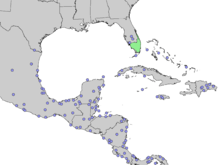Chrysobalanus icaco
| Chrysobalanus icaco | |
|---|---|
.jpg) | |
| Chrysobalanus icaco leaves and flowers | |
| Scientific classification | |
| Kingdom: | Plantae |
| (unranked): | Angiosperms |
| (unranked): | Eudicots |
| (unranked): | Rosids |
| Order: | Malpighiales |
| Family: | Chrysobalanaceae |
| Genus: | Chrysobalanus |
| Species: | C. icaco |
| Binomial name | |
| Chrysobalanus icaco (L.) L. | |
 | |
| Distribution | |
| Synonyms[1] | |
| |
Chrysobalanus icaco, the cocoplum, Paradise Plum and icaco, is found near sea beaches and inland throughout tropical Africa, tropical Americas and the Caribbean, and in southern Florida and the Bahamas.[1] The inland subspecies is Chrysobalanus icaco pellocarpus.
Description
Chrysobalanus icaco is a shrub 1–3 metres (3.3–9.8 ft), or bushy tree 2–6 metres (6.6–19.7 ft), rarely to 10 metres (33 ft). It has evergreen broad-oval to nearly round somewhat leathery leaves (3 to 10 cm long and 2.5 to 7 cm wide). Leaf colors range from green to light red. The bark is greyish or reddish brown, with white specks.
The flowers are small, white, in clusters, appearing in late spring. In late summer it bears fruit in clusters, that of the coastal form being round, up to 5 cm in diameter, pale-yellow with rose blush or dark-purple in color, while that of the inland form is oval, up to 2.5 cm long, and dark-purple.
The coastal form is highly tolerant of salt, so it is often planted to stabilize beach edges and prevent erosion.
Chrysobalanus icaco is also planted as an ornamental shrub. The tree is unable to survive a hard frost. The fruit is edible with a mildly sweet flavor and is sometimes used for jam. The common name for this fruit in Trinidad & Tobago and Guyana is "fat pork".
This plant can also be found on Cayo Icacos in Fajardo Puerto Rico. This island can be visited by water taxi.


See also
| Wikimedia Commons has media related to Chrysobalanus icaco. |
References
Bush, Charles S. and Morton, Julia F. (1969) Native Trees and Plants for Florida Landscaping (pp. 64–65). Bulletin No. 193. Department of Agriculture - State of Florida.
External links
- USDA Plants Profile for Chrysobalanus icaco (coco plum)
- Chrysobalanus icaco at Pacific Island Ecosystems at Risk (PIER)
- Cocoplum at Virginia Tech Dendrology
- Dressler, S.; Schmidt, M. & Zizka, G. (2014). [http://www.africanplants.senckenberg.de/root/index.php?submitForm=true&page_id=77&searchTextMenue=Chrysobalanus+icaco&filterRegionIDs[]=6&filterRegionIDs[]=1&filterRegionIDs[]=2&filterRegionIDs[]=3&filterRegionIDs[]=5 "Chrysobalanus icaco"]. African plants – a Photo Guide. Frankfurt/Main: Forschungsinstitut Senckenberg.